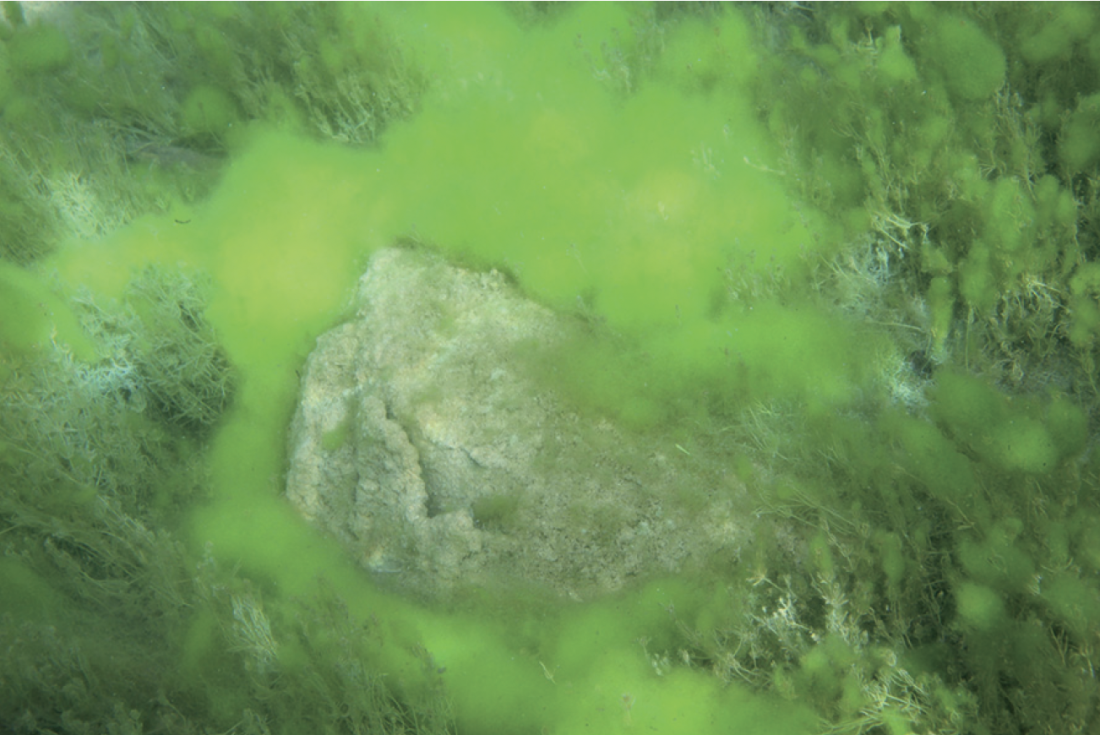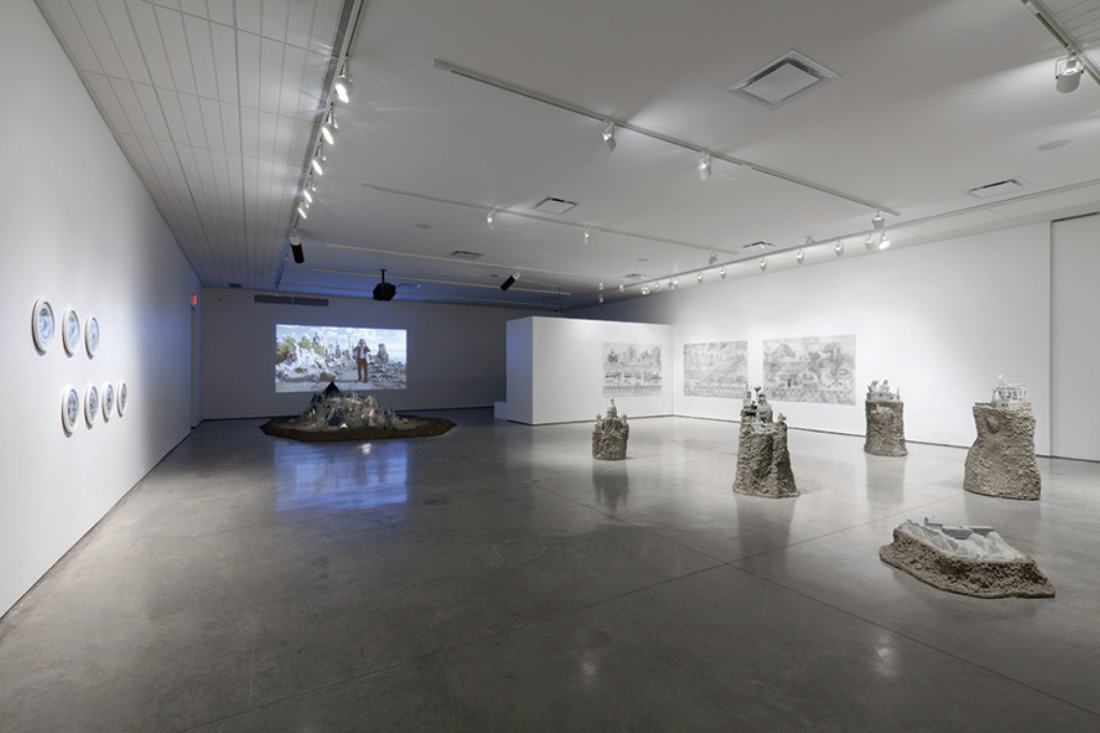Keith Langergraber
Kelowna artist Keith Langergraber’s travelling solo exhibition, “Theatre of the Exploding Sun,” comes out of an obsession with science fiction, time travel, earthworks and phenomena. The exhibition follows the figure Eton Corrasable (played by the artist) as he tries to rectify a rupture in the space-time continuum. In this alternate dimension Robert Smithson has successfully completed his piece, Island of Broken Glass, a large-scale earthwork intended to be installed on an islet in British Columbia’s Strait of Georgia. The creative cost of realizing Island of Broken Glass results in Smithson abandoning Spiral Jetty. As Corrasable discovers, Spiral Jetty is a fixed point in time and its absence causes time to unravel.
For science fiction fans, Langergraber’s film series, “Time Traveller Trilogy,” feels familiar and yet it repeatedly breaks the fourth wall revealing itself as a self-aware meta-fan film. Langergraber’s cinematic trilogy flits between filming vocabulary, adopting the DIY aesthetics of an amateur fan film, grand, cinematic, high-budget shots, or clean clinical documentary presentations. These vernacular changes establish tumultuous space for the films where, similar to Schrödinger’s cat, they can exist simultaneously in multiple contradictory connotative genres, creating a paradoxical experience. The shifts between genre and tone are discordant but point to Langergraber’s analysis of the construction of genre.

Keith Langergraber, untitled underwater image of microbiolytes in Pavilion Lake, BC, 2012. Courtesy Kelowna Art Gallery.
Time/labour become an extension of Langergraber’s performance as Corrasable. The labour that Corrasable has invested in rectifying his state of temporal flux, including visiting the Cayman Islands, building replicas of hoodoos and meticulously journaling are actions that Langergraber has executed. Through various media, the artist has built this alternate universe, exacting and performing the actions of a fanatical Corrasable. His sculptural pieces, entitled Morphological Architecture, look as if a portal has opened and seamlessly attached buildings from different time periods, creating a dystopian architecture. He makes direct reference to model building, an obsessive practice commonly taken up by enthusiasts trying to replicate the USS Enterprise or Cylon Basestar at 1/4190th the scale. Langergraber has playfully altered architect Arthur Erickson’s University Hall at the University of Lethbridge into an “S” Tetris-shaped building, integrated Tatlin’s Tower, and inserted Gothic architecture into an absurd embodiment of a time-shifted reality.
Eton Corrasable seems to be an amalgamation of several sci-fi legends—and yet his character is an entity unto himself. His performance is tantamount to cosplayers embodying their heroes. Fan fiction and cosplay allow for fans to exist in a world they love while taking on the agency of that character or world. Langergraber, who is a fan of many things, has taken ownership of his interests and created a meticulous, layered and fanatical alternate universe. The power that obsessive knowledge holds over creation is prevalent in his work. The similarities between a hardcore fan and an art academic are extensive, especially in the pursuit of a privileged knowledge base. Who is more obsessive than the ultimate fan? His exhibition is brimming with earnest enthusiasm that is contagious; the same reverence, dedication and homage that you would find at Comic Con could arguably be found in this contemporary art show. Both worlds involve a serious amount of cult-practice, manifesting in ultra specific knowledge, idolization, imitation and extensive reading. For Langergraber, trekking to a convention or attending the biennale are as similar as two Cylons. In the same sense, fan fiction is not dissimilar to the lineage of influence and the critique of the art canon in which a deviant or revolutionary narrative stems from a conventional one. There is a juxtaposition between the reverence of a particular subject matter and the willingness to write/perform deviant fan fiction. The freedom of a fanatic includes the ability to create a world inspired by a universe but separate from it—almost like an alternate universe.

Keith Langergraber, installation view, “Theatre of the Exploding Sun,” 2014, Southern Alberta Art Gallery, Lethbridge. Photograph: David MC Miller and Petra Mala Miller. Courtesy Southern Alberta Art Gallery.
Langergraber constantly blurs the line between the unknown mysteries of our universe and Corrasable’s wondrous world. The line between the fictive and the real is so thin that factual aspects are often buried beneath the theatric performance. At the same time that Corrasable is rattling off facts about the underwater microbialite reefs found in the depths of Pavilion Lake, he is also tracking rogue neutrino particles surrounding Donald Crowhurst’s shipwrecked vessel, “Teignmouth Electron,” in the Cayman Islands. It seems as if the artist is not concerned with losing the efficacy of truths within his work, but rather in building a hyperreality comprised of elements of our own sublime world. Layer by layer he piles contradiction atop facts, creating opportunities for tension between the viewer and the work by orchestrating moments where the viewer has enough distance from the work to question it. Self-awareness bubbles up throughout the experience—the slippage between immersion and analysis is part of what makes Langergraber’s exhibition so successful; it isn’t purely an indulgent act of fandom, instead you are witness to an examination of the nature of fandom itself. ❚
“Theatre of the Exploding Sun” is a travelling exhibit that was shown at the Southern Alberta Art Gallery from June 27 to September 7, 2014. It opened at the Kelowna Art Gallery in October 2013 and was at the Richmond Art Gallery from February to April 2014.
Kasia Sosnowski is an artist and writer currently living in Lethbridge, Alberta.

